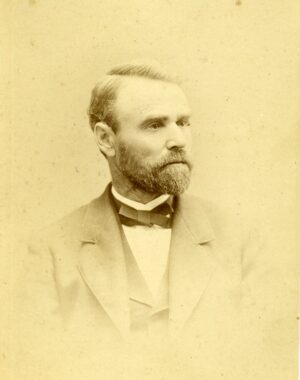This week we celebrate the bicentennial of William Henry Kelley’s birth. And who is this W. H. Kelley? That is a question many people visiting the Kelley House Museum want answered when they walk through the door. He was a remarkable man, and his tale is worth telling.

William Henry Kelley in 1865, thirteen years after arriving in Mendocino. He spelled his family name “Kelly” but some time after his death 1895, the spelling was changed by his children to “Kelley,” as that was the way the original family back in his native Canada wrote it.
William Kelley was born at Morell, Prince Edward Island, Canada, November 2nd, 1821, to Peter and Elizabeth (Webster) Kelley. As the oldest in a family of eight, he began his working life at fourteen. Leaving PEI, he found employment in nearby Eastport, Maine, and after a time there, presumably acquiring some savings, he took ship to the Bermuda Islands in the Atlantic Ocean, undoubtedly as one of the crew.
It was during this time that news of the gold discovery in California was filling the newspapers and minds of adventurous and ambitious men throughout the world. William Kelley was about 28 then, a husky young man, and in 1850, with his younger brother James, he set out for California by way of the Isthmus of Panama.
A steady stream of travelers journeyed across this narrow land bridge, making their hazardous way over the forty-eight miles from the Caribbean Sea to Panama on the Pacific Ocean. The trip, if all went well, took three or four days, at a cost of about $30, but neither time nor money could allay the discomfort. Travelers were urged to bring their own food and avoid eating any of the tropical fruit found along the way in Panama. And if they were lucky, they avoided malaria, yellow fever, typhus, dysentery, and the most dread disease of all, cholera, which could kill a person in a day.
In this unhealthful climate William and James Kelley set up a store. Their business thrived and here William became the astute merchant he would be for the rest of his life. However, within the year of their successful enterprise, both young men contracted cholera. James died an excruciatingly painful death; William very nearly died too.
“The History of the San Francisco Bay Region,” Vol. II, by Bailey Millard (1924) describes his bout with cholera: “Though desperately ill and distracted over his brother’s death, William H. Kelley managed to crawl out of his bed and bury $2000 in the chimney of his room. When the Doctor appeared, he said: ‘You neglected my brother, and if you neglect me, you get nothing, for my money is out of your reach; but if you save me, I’ll pay you well.”
He was saved, and when he was well enough, William found passage on a ship bound for California. After reaching San Francisco and looking over the confusion and the fire-ridden problems of the sprawling town, he went to Benicia, where he got work at ship building.
From there, William Kelley got signed on to the brig “Ontario” as ship’s carpenter. Forty or so other men hired to work in some capacity connected with the sawmill were also on the aged, leaky craft as it sailed into the bay at Big River on July 19th, 1852.
In Big River, now called Mendocino, William began a business career that included general merchandise stores, saloons, a skating rink, and a livery stable. He partnered with others to start the first sawmill at Caspar. As a builder, he constructed his own house and had other structures built for him, including the MacCallum House and a church for his wife. He headed up the construction of the first non-denominational church building on Lansing Street (now Good Life Café). He was a founding member of the Mendocino Masonic Lodge #170 who built their hall across the road from the church a few year later.
Real estate development was also a talent, and it didn’t hurt that he came to Mendocino with cash in his pocket. At one time, William Kelley owned all the land in Mendocino west of Lansing Street, north of Main Street and bounded by the ocean. He bought this in 1854 for $3500 from Mendocino’s first property owner, William Kasten, and sold it in 1858 for $6,000.
He was adept at starting a business, then selling it to others while keeping the land and collecting rental income. By 1860, just seven years after arriving here, his 160 improved acres in Comptche had 8 horses, 158 milch cows, 100 other cattle, and 20 swine that supplied necessary food for the growing town.
Kelley may not have planned that his name would live on in history, but it has, and his home is a memorial to him and his wife, Eliza Owen Kelley, whose life story we’ll cover in the next segment as we celebrate the lives of the Kelley Family.